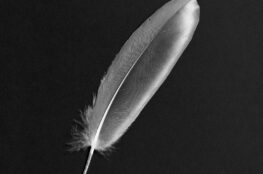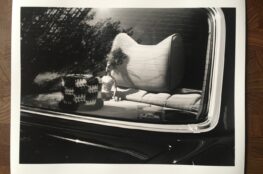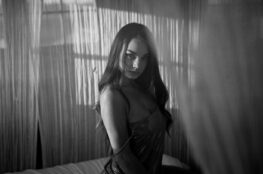The englisch version can be found here.
Arcimboldi Studios ist… der Name den ich benutze wenn ich Dioramen, Aufträge, Collagen und konstruierte Fotografie erstelle.
Instant Possibilities ist… eine Zusammenarbeit mit Trevor Crone (der auch großes Interesse an Sofortbild- und Polaroidarbeiten hat) auf Facebook, es dient uns als eine Onlinegallerie für unsere Sofortbilder und gibt uns die Chance in Kontakt mitähnliche gesinnten Leuten zu treten und Feedback zu bekommen. Außerdem machen wir Magazine aus unserem Output.
Die sozialen Medien zu benutzten… ist eine fantastische Möglichkeit die eigenen Arbeiten zu bewerben und Gleichgesinnte zu treffen um ein globales Netzwerk aufzubauen. Außerdem hilft es dabei, dass die Tradition dass die Besitzer von Gallerien und Medien bestimmten können was gezeigt und verkauft wird.
Gut gekleidet zu sein bedeutet,… dass ich wenger Geld habe das ich für Film ausgeben kann.
Danke für die kurzen Antworten. Kannst du uns jetzt erklären wie du zur Photographie gekommen bist?
Ich wurde Ende der ’60er als Dunkelkammertechniker ausgebildet und wurde dann befördert und war für die Postproduktion von 16 & 35mm Film und Großformatfotografie zuständig. Später habe ich mich dann einer Karriere im IT-Projektmanagement zugwandt. Das war etwa zu der Geburtsstunde des Internets, und mein Job war es neue Technologien wie z.B. Windows, Apple und Photoshop zu implementieren. Letztendlich kam ich dann vor etwa 20 Jahren erneut zur Fotografie.
Was inspiriert dich?
Meine Inspiration kommt aus vielen verschiedenen Bereichen wie der Musik, aus Büchern oder Filmen. Besonderes Interesse habe ich an Filmen aus Osteuropa, hier denke ich an Andrei Tarkovsky und Jan Svankmajer. Ich bin aber auch ein großer Fan von den Quay Brüdern und David Lynch. Wenn ich arbeite läuft immer Musik wie Ambient, Electronica, Jazz und neue (und alte) psychodelische Bands. Ich bin ein großer Fan des britischen Schriftstellers J. G. Ballard, und obwohl all dies nicht offensichtlich present ist sind sie doch irgendwo in meine Arbeit eingeflochten. Gibt es eine bestimmte Philosophie hinter deiner Arbeit?
Gibt es eine bestimmte Philosophie hinter deiner Arbeit?
Es gibt zwei wichtige Standbeine meiner Arbeit. Das eine ist die „konstruierte Fotografie“ und das andere ist meine neue Leidenschaft, die Sofortbild und Polaroid Fotografie. Ich habe vor 10 Jahren damit begonnen Dioramen zu fotografieren nachdem ich mich kurz an der Stop-Motion Animation versucht habe. Ich hatte einen großen Spaß bei der Erstellung der Sets und wie sie dann in den Bildern erschienen, besonders wenn sie erleuchtet wurden und mit Rauch, Dampf und Gasen behandelt wurden. Zu Beginn habe ich sie mit einer Pinhole Kamera fotografiert, nachdem die Sets aber zu komplex wurden bin ich auf eine Nikon F2 und einer Canon D7 umgestiegen.
Zu dieser Zeit starben meine Eltern, und ich begann damit, meine Vergangenheit und die Beziehung zu meinen Eltern erneut zu überdenken. Die Erinnerungen an meine Kindheit, daran wie ich in den zerbombten Teilen von Südlondon gespielt habe, haben sich irgendwie selbstständig in meine Arbeiten geschlichen und kamen nun immer mehr zum Vorschein. Als ich feststellte, dass es bei dem Projekt sowohl um Erinnerungen als auch um das Kind das zwischen Ruinen spielt ging wurde aus der Arbeit das Projekt „Bleak House“.
Etwa 2016 habe ich meine eingelagerte Polaroid Kamera reaktiviert und mit dem Impossible Project Film experimentiert. Ich versuchte die Dioramen damit zu fotografieren oder arbeitet Sofortbilder in meine Sets ein. Ich fühle mich sehr sicher bei der Benutzung von Film und analogen Kameras und nutze sie trotz ihrere Fehler und Eigenarten sehr gerne.
Warum haben viele deiner Arbeiten einen romantischen Flair?
Das liegt wahrscheinlich an der Beleuchtung und der Atmosphere die ich erzeuge. Das erzeugt eine Weichheit, ein nostalgisches Gefühl und fügt den Eindruck einer anderen, magischen Welt hinzu. Manchmal erzeugt es auch etwas humorvolles, in anderen Situationen eine Leere und Traurigkeit. Es gibt viele dunkle Elemente, und was in der Dunkelheit passiert ist genau so wichtig, wie die ausgebrannten hellen Partien. Mir wurde schon gesagt, dass Menschen die Orte aus ihren Träumen kennen, andere Leute finden eine gewisse Ruhe in meinen Bildern. Wie enstehen deine Bilder?
Wie enstehen deine Bilder?
Ich plane das Modell, meist inspiriert durch ein Bild oder einen echten Ort oder durch Erinnerungen aus meiner Vergangenheit. Es kann zwischen 60 und 100 Stunden dauern bis das Modell fertig ist. Wenn das erledigt ist, baue ich meinen „Workshop“ auf und arbeite an der Beleuchtung. Die Bilder enstehen in kompletter Dunkelheit, ich nutze Taschenlampen, LED’s oder kleine Lichtpunkte. Tageslicht kommt nur selten zum Einsatz. Die Belichtung dauert zwischen 30 Sekunden und 2 Minuten, in dieser Zeit setzte ich Licht und nutze Gase oder Rauch. Das ist fast wie ein Tanz, ich muss alles in Bewegung halten. Ich habe schon bis zu 100 Aufnahmen gebraucht um den Look zu erreichen den ich mir vorgestellt habe.
Deine Bilder entstehen digital und werden dann per Instant Lab auf Sofortbild gebracht. Warum schießt du die Fotos nicht gleich als Sofortbild?
Das stimmt so nicht ganz. Ich nutze analoge und digitale Kameras um ein Diorama zu fotografieren. Viele Experimente mit Impossible Project Film wurden mit 35mm Film und der Nikon F2 aufgenommen. Das bringt mir das gewünschte Korn, danach werden die Bilder gescannt und über das Instant Lab gedruckt. Ich habe gerade in eine Mint SLR670S investiert, diese Kamera gibt mir mehr manuelle Kontrolle über die Belichtungszeit mit ihrem B und T Modus. Zusammen mit einem Mint Close-Up Set kann ich dann auch näher heran. Ich muss diesen Aufbau aber noch testen, aber ich hoffe, dass es interessante Ergebnisse liefert.
Wie viel digitale Hilfsmittel kann man deiner Meinung nach benutzten, bevor man nicht mehr von einem analogen Bild sprechen kann?
Ich persönlich nutze Photoshop um die Dinge zu tun, die ich auch vor Jahren in der Dunkelkammer gemacht habe. Es geht um Abwedeln, Nachbelichten, Kontraständerungen und eventuell Weißabgleich oder Farbkorekturen. Ich mache zum Beispiel keine Composings. Ich versuche dies schon in der Kamera zu erreichen. Ich habe mit 2 Bildern HDR versucht aber konnte mich mit den Ergebnisen nicht anfreunden.
Was ist der größte Mythos wenn es um analoge Photographie geht?
Ich höre oft Digital-Fotografen die sich darüber beschweren wie hart es ist bei wenig Licht gute Ergebnise zu bekommen. Man muss nur die Bilder aus dem 19ten und 20ten Jahrhundert ansehem um festzustellen, dass das nicht richtig ist. Wie bei allen Kunstformen muss man über viele Jahre lernen wie man mit dem Equipment und dem Material umgeht um das volle Potential nutzen zu können. Ich denke ich bin mit der Anzahl an perfekten digitalen Bildern überfordert die ich jeden Tag sehe. Sie sehen alle aus wie Klone die aus einer computergesteuereten Produktionslinie kommen. Versteht mich falsch, es gibt da draußen geniale Arbeiten, aber die sehe ich in Workshops oder Gallerien. Ich versuche das „flickrverse“ zu vermeiden.
Was wäre dein Traumprojekt?
Ein Set für ein Theaterstück zu erstellen wäre eine große Herausforderung der ich mich gerne stellen würde.
Hast du einen Tip für Leute die gerne Miniaturmodelle fotografieren würden?
Eine gewisse Vision und Hingabe ist nötig. Da die Zeitspannen sehr lang sein können wird man schnell ungeduldif unf frustriert, besonders wenn etwas nicht so läuft wie man es sich vorstellt (und das kommt öfter vir als man denkt!). Ich wechsle dann zu Collagen, einem anderen Modell oder gehe mit meiner Holga 35mm oder einer Polaroid zu einer „Therapie“ nach draußen. Da du aus England kommst steht auch für dich bald der Brexit an. Was bedeutet das für die analoge Szene in England?
Da du aus England kommst steht auch für dich bald der Brexit an. Was bedeutet das für die analoge Szene in England?
Importierte Produkte wie Film werden eventuell teurer, so zum Beispiel der Impossible Project Film. Wer weiss, vielleicht wird es billiger in Hong Kong einzukaufen?
Welche Frage sollte dir dringend gestellt werden und wie wäre deine Antwort?
Da das Licht sehr hell ist kann man bei deinen Dioramen selten aus dem Fenster sehen. WEisst du was dort draußen ist? – NEIN!
Noch letzte Worte vor dem Ende des Interviews?
Die Soforbild-Community blüht gerade in den sozialen Medien und ich habe viele Leute gesehen die mich inspirieren. In London werden Workshops von Impossible Project und Gallerien angeboten. Das ist ein guter Weg um die Technik und das Konzept unter das Volk zu bringen.
 Mehr von Grame gibt es unter Instant Possibilities und Arcimboldi Studios auf Facebook.
Mehr von Grame gibt es unter Instant Possibilities und Arcimboldi Studios auf Facebook.
Arcimboldi Studios is… The name I work under when creating Diorama cabinets, commissions, collage and constructed Photography.
Instant Possibilities is… A Facebook collaboration between myself and Trevor Crone who also has an interest in Instant and Polaroid technology, it acts as a online gallery for our instant images and allows us to interact, network and gain feedback from other like minded souls. We are also producing Zines of our output.
Using social media is… a fantastic opportunity to promote ones work and to meet like minded individuals and network across the world. it is also helping breakdown the old established order of the gallery and media owners dictating what is shown and what is sold.
Being well dressed means… I have less money to spend on film.
 Thank you. Now could you please tell us a little bit about you? How did you get into photography?
Thank you. Now could you please tell us a little bit about you? How did you get into photography?
I trained as a darkroom technician in the late 1960’s and graduated to large format photography and 16 & 35mm Film and postproduction. I later left all this behind and pursued a career in IT project management for many years. I was around at the birth of the internet implementing these new technologies in a global engineering company and the introduction of Windows, Apple and Photoshop. I finally returned to media production and photography around 20 years ago.
What inspires you?
I find inspiration from many areas, Music, books and films, I have an interest in East European film, Andrei Tarkovsky and Jan Svankmajer come to mind, Im also a big fan of the Quay Brothers and David Lynch, his art and films. I always have music playing when Im working Ambient, Electronica, Jazz and New (and old) Psychedelic bands. Im a big fan of the British writer J G Ballard and although these things are not overtly present in my work they are somewhere there in the mix.
Is there a certain philosophy to your work?
There are two strands to my work. The main one is the constructed photography and to a lesser degree my more recent revived interest in Instant photography and Polaroid cameras. I started working on the diorama photography 10 years ago after a brief involvement with stop motion animation. I enjoyed the making of sets and the way they appeared in photographs especially when lit and treated with smoke, steam & aerosols. I initially photographed these with a pinhole camera, soon the sets became so complex that the pinhole camera was swapped for a Nikon F2 and a Canon D7.
About this time I lost both my parents and I started to reflect on my childhood and my relationship with them. These memories of childhood, playing in the post war bomb damaged areas of south London seemed to be working themselves into the constructions, a little at first then becoming more prominent. As these evolved I realised the project was as much about memory as it was about the child playing amongst the ruins, The Project became ‘Bleak House’.
Around the middle of 2016 I retrieved my Polaroid kit from storage and started messing around with Impossible Project film with the idea of incorporating it into my diorama work, either by using it to photograph sets or collaging the film into the the sets in some way. This has led to exploring the use of IP film in art works utilising my skills as a model maker. I feel very relaxed in using instant films and cameras and like to embrace all its faults and idiosyncrasies.
How come most of your photos have a certain romantic touch?
Its probably in the lighting and atmosphere that I generate, this softens and adds a other worldly and arcane feel to the images and a feeling of nostalgia, sometimes they contain humour, other times emptiness and sorrow. There are many dark elements to the images and what happens in the shadow areas is as important as the burnt out highlights. Some people have told me that they feel they have been to these places in dreams others find them comforting and quite places, its all very interesting. How do you create your photos?
How do you create your photos?
I plan out the model, this is normally inspired by a picture or place that I have seen in the past, many are memories from many years ago. It can take between 60 and 100 hours to build the model. When this is complete Ill set it up in my workshop and start working on how I will light it. They are photographed in the dark, I can use torches, LED’s or small spots or a combination I very rarely use daylight. Exposures can be anywhere from 30 seconds to 2 minutes and over this period I will ‘hose’ the light and add smoke or aerosols to mist the light. This is almost like performance art as I have to keep everything moving at the same time. It can take over a 100 exposures to get the effect Im looking for.
You shoot your built models using an analog camera and then create the polaroid by using the instant lab. Why don’t you shoot the polaroid straight away?
I use both analog and digital for the ‘diorama capture’. The experiments I have carried out with IP film has been done with the F2 using 35mm film stock this breaks down the image and gives it a grainy feel I then digitise the negative and print through the IP Universal Lab. This gives me some control. I do need high resolution images from these dioramas for other purposes so I use the Canon 7D for these. I have just invested in a Mint SLR670S which will give me manual control over the exposure with its B and T settings this coupled with A Mint Close up set will enable me to get in closer. I have yet to test this setup out but it will certainly produce different and I hope interesting results.
How much digital utilities can one use and still call the photo an analog shot? What’s your opinion?
Personally I use Photoshop to do the sort of thing I would do in the darkroom years ago dodging and adjusting contrast levels, maybe colour or white balance correction. I don’t use compositing or mattes. I try to do everything ‘in camera’ using practicals and back projection in some cases. In 2 images over the years I experimented with HDR but was not convinced that it was for me.
What’s the biggest myth about analog photography?
I hear digital photographers banging on about how hard it is to get good results in low light. You only have to look at the photographers of the 19th and early 20th century to realise this is not correct. Like all art forms one has to learn to work with the materials and tools over many years to realise their full potential. I find I am overwhelmed with the amount of images I see daily the perfect digital image that looks like all the others from a computer controlled production line each one a clone of the other. Don’t get me wrong there is good work out there, I see it at workshops and galleries I attend, but the flickrverse I tend to avoid.
What would be your dream project?
Theatre set design and production would be a challenge that I think I could rise to.
Is there any advice you could give to young photographers wanting to shoot miniature models?
I think some sort of vision and dedication to the project is required. Because project timescales can be quite long it is quite easy to become impatient or frustrated with it especially when things don’t turn out the way you thought they would (and they do on a regular basis) I shift over to collage, another model or go out with the Holga 35mm or Polaroid camera for a break for some ‘therapy’.
Being an UK based photographer, what will the Brexit mean to the analog photography scene in the UK?
Imported products like film from the EU may go up in price which could affect the price of The Impossible Projects product for instance. Who knows it might be cheaper to buy it from Hong Kong.
What’s the question you’re still waiting to be asked in an interview and how would you answer it?
It is very rare in your dioramas to see through the windows as the light is very intense, do you know what is out there? – No
Any last words?
The instant photography community is thriving especially on social media and I have come across many that have inspired me. In London there are workshops run by Impossible Project and the Photographers Gallery and this can only be a good think in promoting the concept and technology.
 You can find Instant Possibilities and Arcimboldi Studios on Facebook if you want to see more of Graeme’s work
You can find Instant Possibilities and Arcimboldi Studios on Facebook if you want to see more of Graeme’s work



